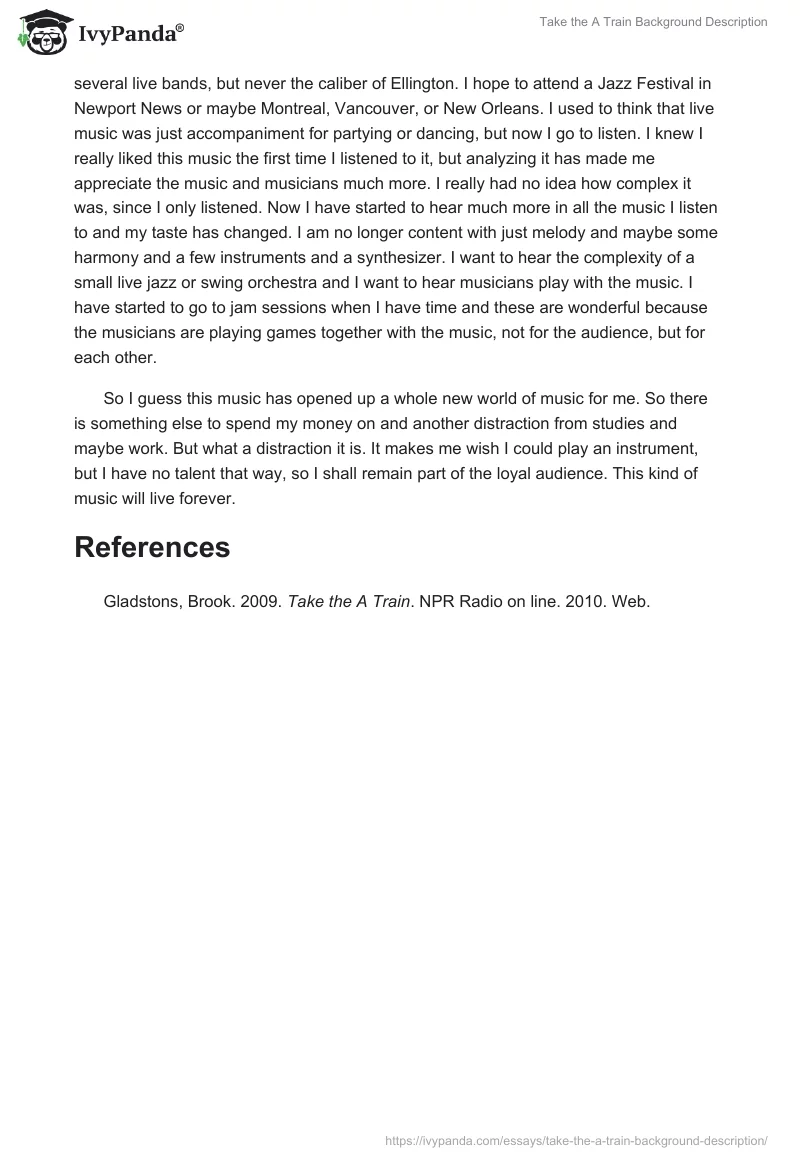It is interesting to note that this composition was actually in the trash because Strayhorn thought it sounded too much like Fletcher Henderson. (It does have echoes of Henderson.) In those days, radio was all live, and ASCAP had ruled that Duke Ellington could no longer play his theme on radio, due to some copyright or publishing issues. So Ellington asked Strayhorn and his own son, Mercer, to write a whole new batch of songs to be registered with BMI, the competing artists’ licensing group. (Gladstone 2009)
The title references the train which goes from Brooklyn to Harlem in New York. After Ellington had hired Strayhorn he had written direction for him to get to Ellington’s house in Harlem, and they began with “Take the A Train”. Billy got to think9ing about doing something like Henderson did with horns and Take the A Train was the result. The lyrics were added later by a vocalist, Joya Sherrill, whom Duke hired for her voice and poise. Throughout his career, Ellington was always sophisticated even with Jazz. It was never low-brow noise, but always complex music for musicians.
“Take the A Train” combines the easy rhythm of the 1940s swing era and the jazz of the 1950s. It has been played and sung by many major recording groups and artists, including Jo Stafford and Ella Fitzgerald. It became the signature tune of Duke Ellington and is still recognized as his theme. The social context of this music was the upper-class black of Harlem on Sugar Hill. It is a timeless jazz piece and a favorite of bands everywhere. Mostly it is simply a lot of fun to play, from what musician friends tell me. It is easy to modulate into different keys for different solo instruments and lends itself to scatting by jazz vocalists.
For me, this piece is symbolic of great jazz. Much of today’s jazz seems repetitive and sad. “Take the A Train” somehow lends itself to endless variation and never seems repetitive. Perhaps I have only heard it done by experts, so I may be mistaken on this point. Swing is really great to dance to and energizing, yet it creates a warm background for any party. I like to put it on when I study, because its complexity may actually help me learn. At least that is my excuse. I have heard this performed by several live bands, but never the caliber of Ellington. I hope to attend a Jazz Festival in Newport News or maybe Montreal, Vancouver, or New Orleans. I used to think that live music was just accompaniment for partying or dancing, but now I go to listen. I knew I really liked this music the first time I listened to it, but analyzing it has made me appreciate the music and musicians much more. I really had no idea how complex it was, since I only listened. Now I have started to hear much more in all the music I listen to and my taste has changed. I am no longer content with just melody and maybe some harmony and a few instruments and a synthesizer. I want to hear the complexity of a small live jazz or swing orchestra and I want to hear musicians play with the music. I have started to go to jam sessions when I have time and these are wonderful because the musicians are playing games together with the music, not for the audience, but for each other.
So I guess this music has opened up a whole new world of music for me. So there is something else to spend my money on and another distraction from studies and maybe work. But what a distraction it is. It makes me wish I could play an instrument, but I have no talent that way, so I shall remain part of the loyal audience. This kind of music will live forever.
References
Gladstons, Brook. 2009. Take the A Train. NPR Radio on line. 2010. Web.


